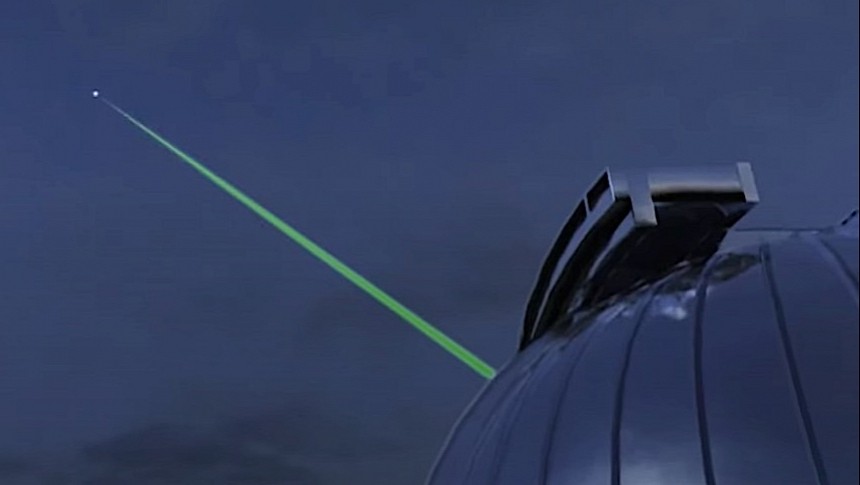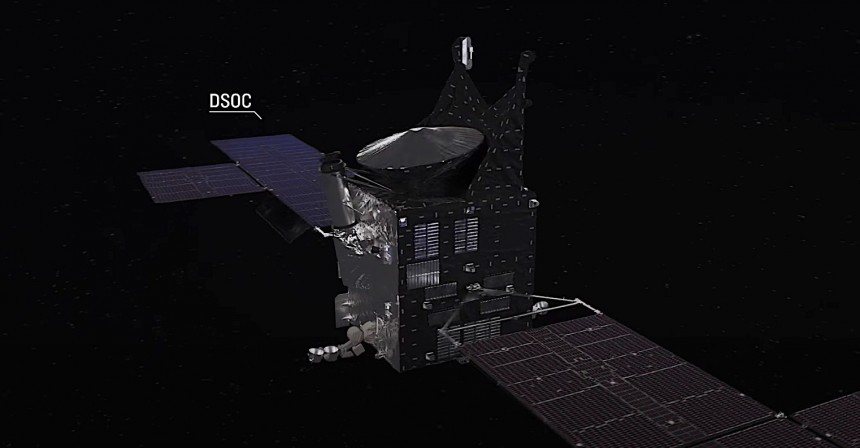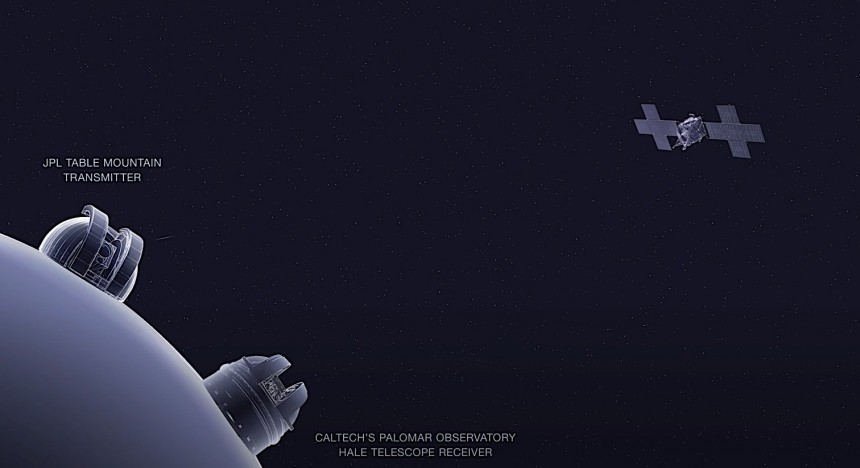A little more than a month ago, the Psyche spacecraft took off, heading for a namesake "unique metal asteroid orbiting the Sun between Mars and Jupiter." It's not there yet (and it won't be until 2028), but that doesn't mean the spacecraft can't do science yet.
The mission does not limit itself to studying an asteroid that may or may not be "the partial core of a planetesimal, a building block of an early planet," but also has a series of other experiments to conduct along the way.
One of them is a piece of technology called Deep Space Optical Communications, or DSOC. In a nutshell, we're talking about something that's meant to show if and how Earth can communicate with deep space using high-bandwidth optical hardware.
DSOC is essentially a powerful modulated laser and a laser transceiver that will be used to transmit high-bandwidth test data to a receiver, but also to get instructions. In doing so, the tech is supposed to prove humanity does have alternatives to the radio frequency-based comms currently used in space exploration.
True, both radio and laser comms work in similar ways - they both take advantage of electromagnetic waves to send data - but only near-infrared lasers can wrap all that data in tighter waves, thus making it possible to send a lot more than before.
In the case of the DSOC, data is encoded as bits in the laser's photons and literally beamed down to a receiver. Once delivered, the lasers go through a detector array where photons are identified.
Once that is out of the way, signal-processing techniques that are brand new or just being developed are used to extract the encoded data.
NASA set up the receiving and decoding gear at the Hale Telescope located at the Caltech Palomar Observatory in San Diego, California. It is from there that we got news this week of the DSOC performing something called first light – that is the first successful attempt to communicate with Earth.
More to the point, Psyche shot a laser beam at our planet on November 14, from a distance of 10 million miles (16 million km). In words that are a tad easier to understand, that's 40 times the distance that separates our planet from the Moon, and at the same time the farthest distance ever used to demo an optical communication tech.
Although aiming a laser beam from such a distance to a specific point here on Earth was not easy, NASA's people managed to make the moment a reality, opening the doors to a system that in their view "could transform how spacecraft communicate."
The test, the first in a series to be performed over the coming two years, was the first time both the spacecraft's transceiver and the ground components of the system were put to use. Both the uplink and downlink lasers (meaning the one on the ship and the other located in California) were also active during the run.
As per the American space agency, the test showed DSCO can send, receive and decode. We are not given any details on exactly what kind of data was transmitted, but we do know it had nothing to do with the Psyche spacecraft or the mission it set out to complete.
Following this first test a number of (many) others will follow. The first thing on the agenda is to finetune the "systems that control the pointing of the downlink laser aboard the transceiver." That's because DSOC is attempting something that was never tried before.
We've had over the years optical comms tech being deployed in low-Earth orbit, and even as far out as the Moon, but never before so far into deep space. And that poses significant challenges due to the distances involved.
You see, sending a message from so far out is not as simple as pointing a laser at a receiver and letting it rip. True, that's an important part of the procedure, but constant adjustments to the direction of the beam have to be made, because both the sender and the receiver are constantly moving through space.
This week's message from Psyche, for instance, took 50 seconds to reach us. During all this time, the position of the spacecraft, the Hale Telescope, and even Earth itself, changed. Had the beam been left uncorrected, it wouldn't have reached its intended destination.
Future tests will be even more challenging. At the maximum distance between Earth and Psyche, for instance, the delay between the laser being released and it being received will grow to an impressive 20 minutes!
In light of future missions, including crewed ones, across the solar system, developing new methods of communication will prove crucial. Several options are currently on the table, but the DSOC comes with the promise of higher-resolution images, larger volumes of science data, and even video streaming from as far out as Mars.
In all, the tech has the potential to achieve data transmission rates that could be 100 times greater than the best radio frequency systems currently at our disposal.
One of them is a piece of technology called Deep Space Optical Communications, or DSOC. In a nutshell, we're talking about something that's meant to show if and how Earth can communicate with deep space using high-bandwidth optical hardware.
DSOC is essentially a powerful modulated laser and a laser transceiver that will be used to transmit high-bandwidth test data to a receiver, but also to get instructions. In doing so, the tech is supposed to prove humanity does have alternatives to the radio frequency-based comms currently used in space exploration.
True, both radio and laser comms work in similar ways - they both take advantage of electromagnetic waves to send data - but only near-infrared lasers can wrap all that data in tighter waves, thus making it possible to send a lot more than before.
In the case of the DSOC, data is encoded as bits in the laser's photons and literally beamed down to a receiver. Once delivered, the lasers go through a detector array where photons are identified.
Once that is out of the way, signal-processing techniques that are brand new or just being developed are used to extract the encoded data.
More to the point, Psyche shot a laser beam at our planet on November 14, from a distance of 10 million miles (16 million km). In words that are a tad easier to understand, that's 40 times the distance that separates our planet from the Moon, and at the same time the farthest distance ever used to demo an optical communication tech.
Although aiming a laser beam from such a distance to a specific point here on Earth was not easy, NASA's people managed to make the moment a reality, opening the doors to a system that in their view "could transform how spacecraft communicate."
The test, the first in a series to be performed over the coming two years, was the first time both the spacecraft's transceiver and the ground components of the system were put to use. Both the uplink and downlink lasers (meaning the one on the ship and the other located in California) were also active during the run.
As per the American space agency, the test showed DSCO can send, receive and decode. We are not given any details on exactly what kind of data was transmitted, but we do know it had nothing to do with the Psyche spacecraft or the mission it set out to complete.
Following this first test a number of (many) others will follow. The first thing on the agenda is to finetune the "systems that control the pointing of the downlink laser aboard the transceiver." That's because DSOC is attempting something that was never tried before.
You see, sending a message from so far out is not as simple as pointing a laser at a receiver and letting it rip. True, that's an important part of the procedure, but constant adjustments to the direction of the beam have to be made, because both the sender and the receiver are constantly moving through space.
This week's message from Psyche, for instance, took 50 seconds to reach us. During all this time, the position of the spacecraft, the Hale Telescope, and even Earth itself, changed. Had the beam been left uncorrected, it wouldn't have reached its intended destination.
Future tests will be even more challenging. At the maximum distance between Earth and Psyche, for instance, the delay between the laser being released and it being received will grow to an impressive 20 minutes!
In light of future missions, including crewed ones, across the solar system, developing new methods of communication will prove crucial. Several options are currently on the table, but the DSOC comes with the promise of higher-resolution images, larger volumes of science data, and even video streaming from as far out as Mars.
In all, the tech has the potential to achieve data transmission rates that could be 100 times greater than the best radio frequency systems currently at our disposal.










